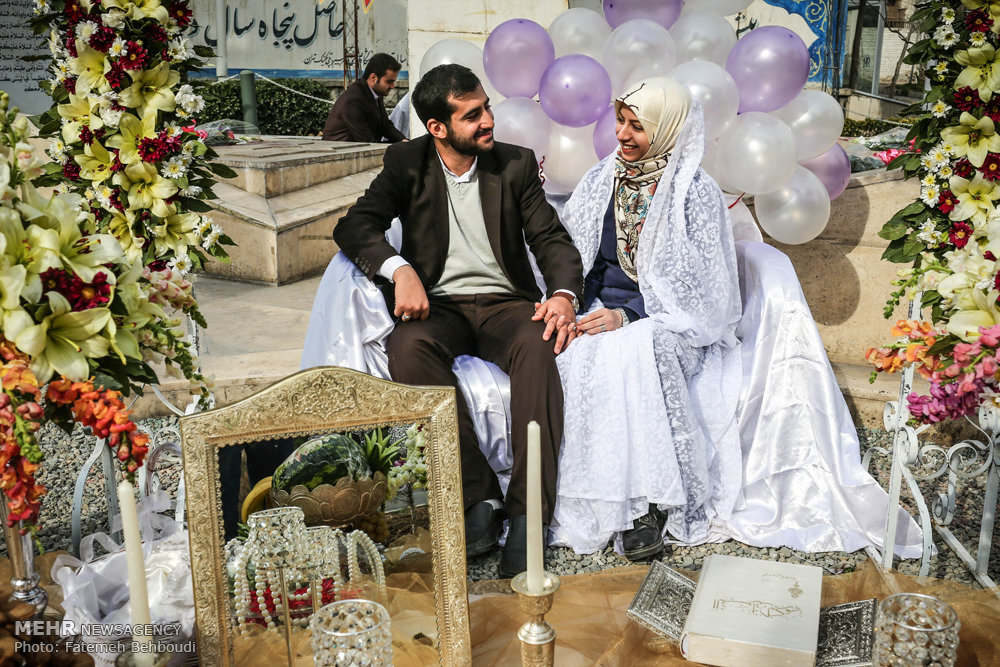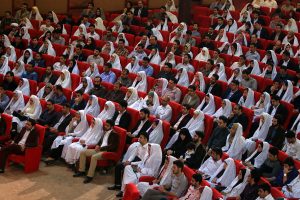
Five hundred young couples, hand in hand, sit next to each other in the amphitheater of Tehran University. Girls are wearing white Chadors (a symbolic sign for a bride), colorful loose scarves and make up. Next to each girl, a young man is sitting with a jacket thrown over a shirt, or a T-shirt. Some girls have a bouquet of roses on their laps; other simply one red rose in their hand.
This may look like a seminar or graduation, but it’s actually a wedding ceremony. It starts with speeches given by the university directors, followed by music; there is no dance, but the audience accompany the music with rhythmic applause and sometimes singing. A few stand-up comedians are invited to change smiles into laughs.
Each couple have few minutes to stand at the “wedding setting” and capture their special day on camera. Eventually the ceremony is concluded with the reception. Then the next day, newly wedded couples depart for a three-day trip to the holy city of Mashhad, organized by the university that married them.

The ‘Students’ Wedding Ceremony’, held by both public and private universities, is a program launched in 1997 to encourage students to marry and help them to reduce their costs. Annually it has an average participation of 25,000 couples, and over the last twenty years about 400,000 student couples have got married through the program, according to its organisers.
“At last year’s ceremony, 30% of couples were both students, and for the other 70%, one party had already graduated”, said Mr. Mohammad Mohammadian, Representative of Iran’s Leader at the Universities, to the Iranian Student News Agency (ISNA). “About 60% are 20 to 23 years-old, i.e. bachelor students. These young people are very courageous to marry, because most of them are jobless.”
One of the reasons attracting students to marry through the scheme was the financial support they could receive from their university. In addition, students from other provinces were offered matrimonial dormitories. But over the last years, gaining this support has been almost impossible. Instead the majority of students marry outside such programs. Estimations indicate that about 10% of the total marriages in Iran annually happen among the students.
Farzaneh, 25, and her husband, Saman, 26, are enrolled at the first year of Master degree of Economics at Tehran University. I met them at Khatam University, a private university belonging to Pasargad Bank, where they work part-time with their supervisor to develop the faculty of Economics.
They married two years ago, when Farzaneh was about to finish her bachelor of Chemical Engineering at Sharif University of Technology, the best technical university in Iran, and Saman had started his Masters in Tabatabaii University in Tehran.
“Our acquaintance began while working on a project together”, says Saman, wiggling in his chair behind his desk. “The result of the project was that the Revolutionary Guard of Iran and Bonyad (two conservative organisations) were obliged to pay taxes in favour of science”.
Once the project was concluded, Saman tried to set up more meetings with Farzaneh, which she initially rejected: “I was not interested in him!”, continues Farzaneh, sitting behind the desk next to Saman. “But finally, I accepted. We were meeting every day and talking to each other for almost twenty hours a day! No romantic discussion, but general talks which could show how each one of us think about life.”.

Three months later, their decision was made. Initially both families objected to their marriage. Saman’s mother would have prefered to find him a girl from Qazvin, about 150 km north of Tehran, where they live.
“I come from Sirjan, a boring city in Kerman Province. My mother said, ‘why should we have a groom from thousand kilometers away?!’ She was worried that if I marry in Tehran, I would never go back to my city”.
In couple of months both families were convinced. Saman and Farzaneh got married six months after they first became acquainted. Resuming their study, they got lucky and rented a small apartment close to Tehran University, for only 200 Euros per month. But at work, they are paid 200,000 IRR per hour (4.7 Euros) and their monthly salary together does not exceed 1200 Euros.
When I ask why they did not prefer to continue as friends for a while, Farzaneh answers: “friendship is temporary. I wanted to have him for myself. If I am directing my life according to him, I want to be sure that I do it for someone who stays in my life.”
After his Master degree, Saman is subjected to two-years military service – obligatory for men in Iran. “Our capacity to handle uncertainties in life is high”, recounts Farzaneh with a serious expression. “Thanks to his education, Saman can replace his military service with a research project, for which he will not be paid. This may decrease our salary for a while, but it is better to pass this period together, rather than I would wait for him and getting married once it is finished.”
During her bachelor, Farzaneh shared a room with four other girls at the dormitory. All of them have got married too. “Somehow when one couple marries, the others follow suit”, she says. Of them, two have already divorced.
Schools in Iran are separated, and university is the first place where boys and girls are freely mixed. Studying together, hanging out and participating in trips organised by the universities, suddenly the social orders of childhood change and new kinds of relationships spring up.
But traditional and religious constraints forbid any kind of sexual relationship outside marriage. These traditions aren’t exclusive to Muslim families in Iran, but exist among other religions as well. For many young lovers, it’s hard to see any choices in front of them other than marriage. However, many of them are not aware of the responsibilities which follow the wedding day.
The divorce rate in Iran is 24% according to the Centre of Statistics, and in some cities it reaches 60%. In 2016, about 40% of all the divorces happened among couples aged 20 to 35 years-old. In 2006, that share was 50%. Perhaps unsurprisingly, this range coincides with the age most that young Iranians attend university.
Over the last decade, several old houses in downtown Tehran have been turned into lovely cafés, with tables scattered in their back yards. Waiters are young boys and girls working together.
On a hot afternoon in one such café, I met Omid, age 30, a physicist who teaches mathematics and physics at private high schools. “Things are changing very fast. Today’s teenagers are very different from our generation. All of my pupils possess a smartphone. Internet makes communication for them much easier. Today not having a girlfriend seems weird among them.”
“When I was a twenty-year-old boy, I knew nothing about girls. At the university, I was falling in love with girls who had nothing in common with me and disappointment was not a surprise. Finally, life taught me things I had not learnt at school or from my family. Now, in my classes, I try to explain these things to my students”, says Omid as he glances at the table next to us.
A group of twelve have arrived to celebrate a birthday. Their average age doesn’t seem more than twenty. New arrivals hug and kiss everyone in the group, and many arrive in a couple. With birthday-caps on their heads and big smiles on their faces, they take non-stop selfies.
In this relaxed place, the formality and structure of the mass wedding feels a long way away. Will the Student Wedding Ceremony survive for much longer?


